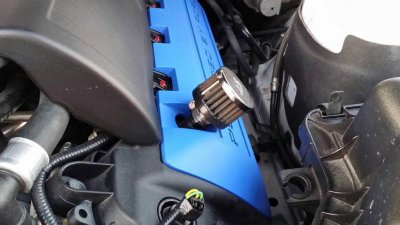You wouldn't need to use a vacuum pump. Plenty of the Mustang guys just buy breathers instead of oil separators, which do exactly what you said. It vents the crankcase vapors to the atmosphere like this one here. You can see it mounted on the driver side cylinder head on this Boss 302.
View attachment 22042
The problem is with this is that breathers that vent to the atmosphere quickly become overly saturated and before you know it, your entire engine bay is covered in a thin film of oil. Wouldn't recommend you go this route.
In reality, the single side JLT oil separator that has become the topic of this thread doesn't do anything on an ecoboost motor because it's not a dual valve. If you were to look at the intercooler after a few thousand miles even with that JLT, it will be coated in oil for sure. Sure the JLT will catch some vapors, but the vast majority will still end up in the charge air cooler. On a non-Forced Induction engine, placing the oil separator on the passenger side is enough. Fresh air is pulled into the driver side cylinder head and evacuated out the passenger side cylinder head back into the intake manifold. All of this occurs due to vacuum. However, with turbocharged and supercharged engines, oil vapors can actually be pushed backwards to the fresh air side, which on the ecoboost motor is the intake tube connecting to the driver side turbocharger. When this happens, oil vapors condense in the intercooler and mix with the fresh charge air. This is why the majority of what an oil separator will collect is water vapor.
Bottom line, either go with a dual valve like this one or don't bother at all:
https://www.amazon.com/TEAM-RXP-CAT...dt-20&linkId=faeede562a7550134fc0969bba576fb2
Be aware though, this type of oil separator isn't plug an play like the JLT and requires more mechanical intuition to install. You will also have to drill a hole into the intake tube to pull the vacuum and those of you worried about warranty issues will most likely really have a problem with this.
@Muddy Bean you are correct though. Unless Ford has released an update within the past year, there is no Ford approved method to clean the backside of the intake valves. With direct injection, there is no fuel that washes over the backside to consistently clean the valves. Some manufacturers have approved methods such as walnut-shell blasting, but Ford's only option should a serious enough issue result from valve coking is to replace the cylinder head. Advertised options such as the CRC Valve Induction Cleaning should be avoided! When this is done, chunks of carbon can break off the valves and end up between the cylinder walls or worse eating a turbo.
The 2017 and on F150's and the 2018 an on Expeditions have the next generation ecoboost that has both direct and port injection, where you get the power benefits from direct injection but the cleaning benefits of port injection.
Do I think the issue of oil separators is overblown?, yes. Will it hurt to install one?, certainly not. In fact I have one on my Mustang GT, and my system looks spotless because of it. Will I put one on my ecoboost expedition?, no, I bought it used. With more than a million ecoboost motors on the road with many over 200,000 miles, and the R&D associated with FoMoCo, I don't see it as an issue. If it helps someone sleep at night, then no issue putting an oil separator on. Your system will be cleaner because of it. Funny thing to me though, is most of the guys who put one on end up selling their vehicle within the next few years anyway. Rather, they just go through the "it's my new vehicle and I need to do all the preventive maintenance possible since I'll keep it forever" stage. Get on the gas hard every once in a while and your ecoboost will keep ticking for longer than most will own it.


